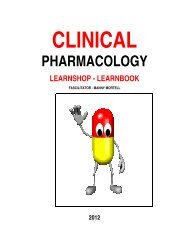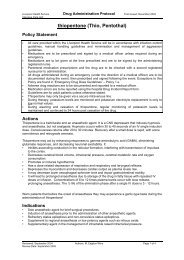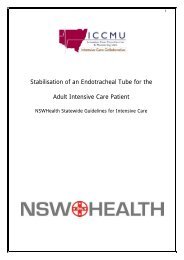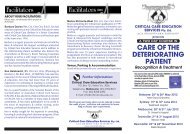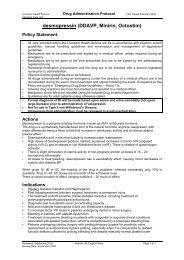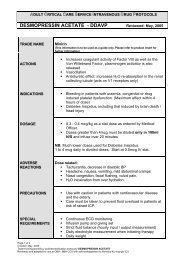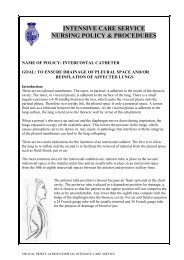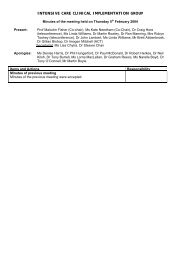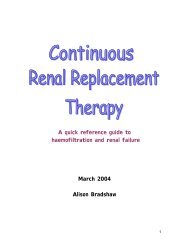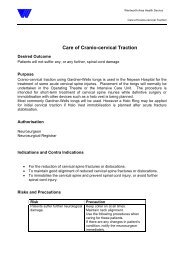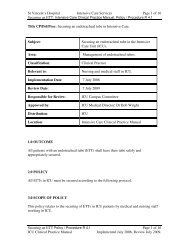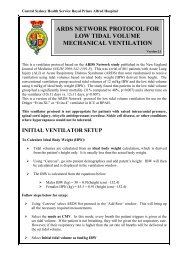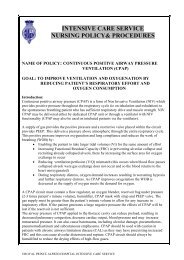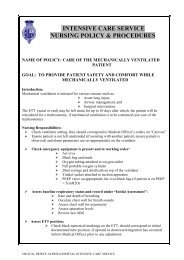Nursing care of the ventilated patient (SWAHS) - Intensive
Nursing care of the ventilated patient (SWAHS) - Intensive
Nursing care of the ventilated patient (SWAHS) - Intensive
You also want an ePaper? Increase the reach of your titles
YUMPU automatically turns print PDFs into web optimized ePapers that Google loves.
W e s t e r n<br />
S y d n e y<br />
A re a H e a lth S e rv ic e<br />
H E A L T H<br />
<strong>Nursing</strong> Care Of The Ventilated Patient<br />
<strong>Intensive</strong> Care<br />
Evidence Based Practice Guidelines<br />
2003<br />
Eye Care:<br />
• The unconscious, sedated or paralyzed <strong>patient</strong> is at risk <strong>of</strong> developing eye problems<br />
ranging from mild conjunctivitis to serious corneal injury and ulceration. Permanent<br />
eye damage may result from ulceration, perforation, vascularization and scarring <strong>of</strong><br />
<strong>the</strong> cornea.<br />
• Sedation and muscle relaxants can lead to inadequate closure <strong>of</strong> <strong>the</strong> eye, lack <strong>of</strong><br />
random eye movements and a loss <strong>of</strong> <strong>the</strong> blink reflex, all <strong>of</strong> which can lead to<br />
complications.<br />
• Fluid imbalances and increased permeability can promote conjunctival oedema.<br />
• Constrictive securing tapes can compromise venous return from <strong>the</strong> head leading to<br />
venous congestion and maybe an increase in interocular pressure and <strong>the</strong>refore an<br />
increase in conjunctival oedema.<br />
• 2 nd hourly eye <strong>care</strong> using saline soaked gauze to clean <strong>the</strong> eye and <strong>the</strong> application <strong>of</strong><br />
lactrilube regularly in <strong>the</strong> <strong>ventilated</strong> <strong>patient</strong> is recommended to help reduce <strong>the</strong> risk <strong>of</strong><br />
complications.<br />
G.I.T:<br />
• Intubated <strong>patient</strong>s must have a nasogastric tube for gastric decompression or<br />
nutritional support.<br />
• The presence <strong>of</strong> bowel sounds and <strong>the</strong> turgor <strong>of</strong> <strong>the</strong> abdomen should be assessed<br />
during <strong>the</strong> initial assessment.<br />
• Nutrition and hydration are essential to build respiratory muscle strength necessary<br />
when a <strong>patient</strong> is being weaned from a ventilator. Patients who have inadequate<br />
nutritional stores are prone to infection, fluid and electrolyte imbalance, intestinal<br />
fluid retention, weight loss, pressure areas and poor wound healing.<br />
• Patients with a functioning GI tract should be fed enterally. TPN may be used if <strong>the</strong>re<br />
are contraindications to enteral feeding.<br />
• The enterally fed <strong>patient</strong> should be monitored for diarrhoea, dehydration, fluid<br />
overload, constipation or abdominal cramping. These observations can be a guide in<br />
determining <strong>the</strong> strength and rate <strong>of</strong> increase <strong>of</strong> <strong>the</strong> feeds.<br />
• NG tubes should be flushed with 20-30 mls <strong>of</strong> water before and after administering<br />
medications.<br />
• Fine bore tubes can not be aspirated but should be flushed 4 hourly with water.



